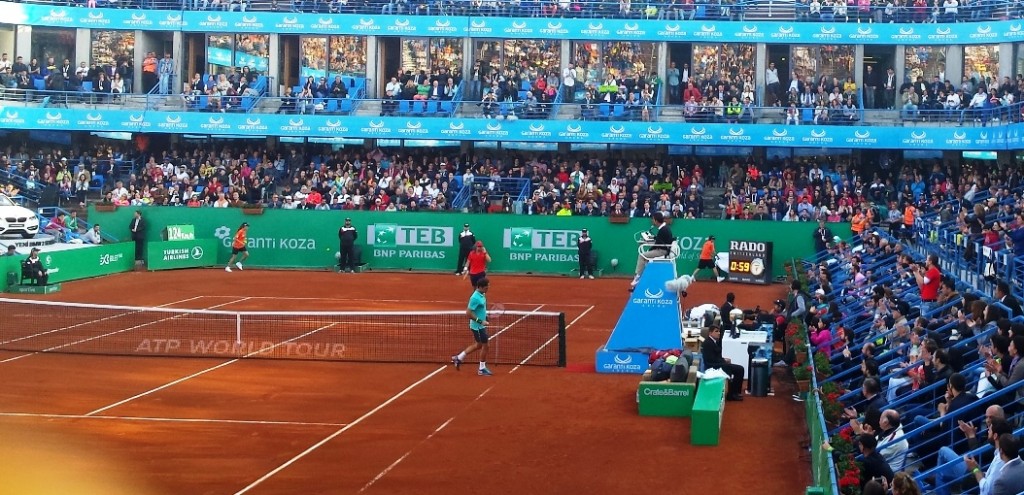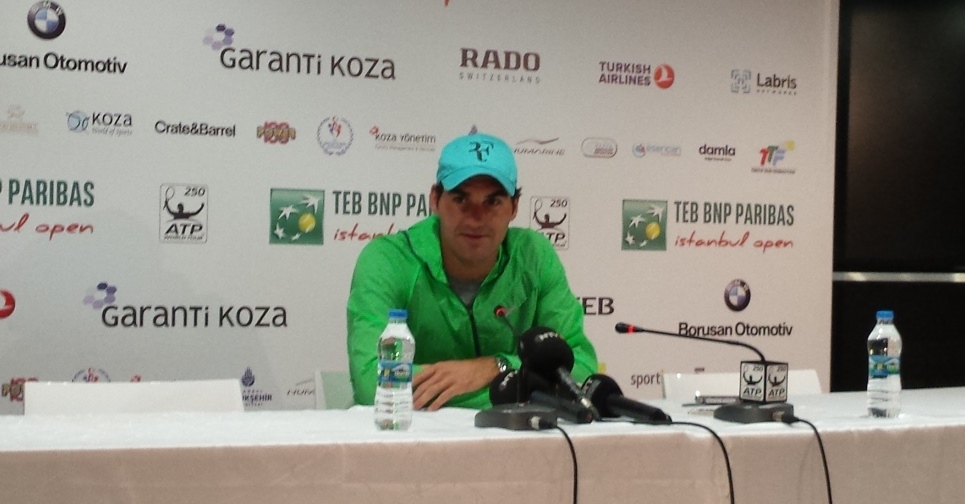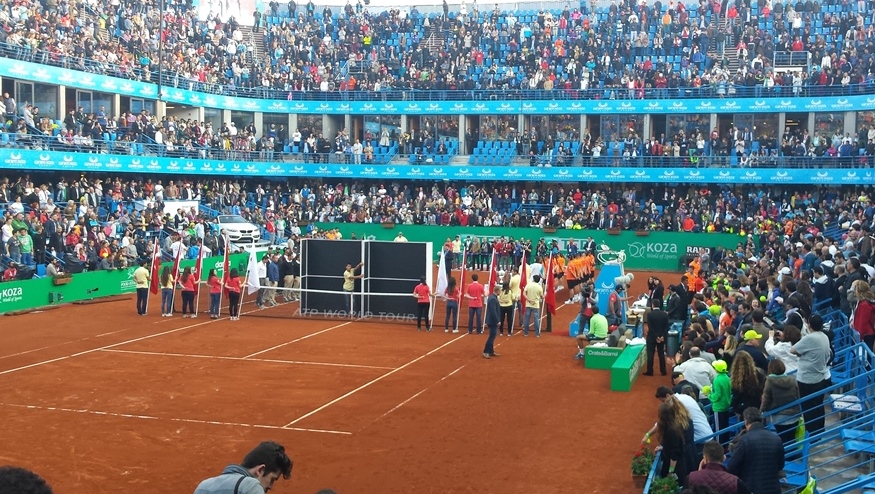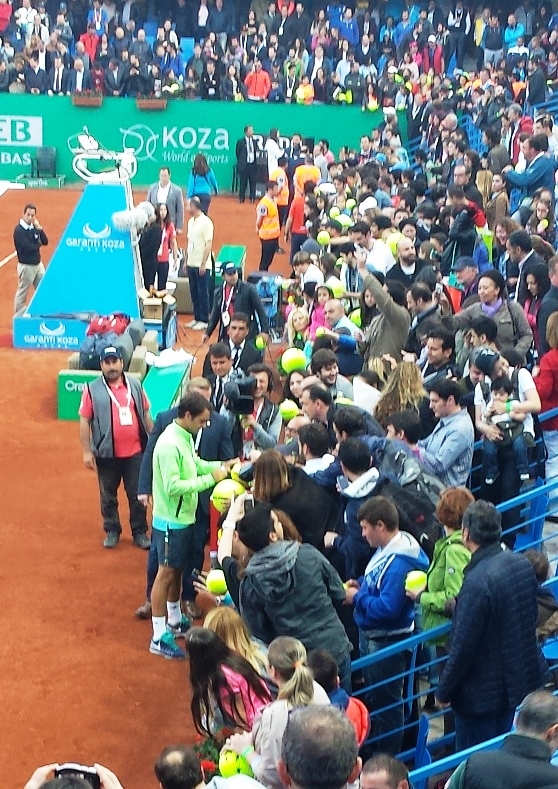Part 1: Cuevas and Federer engage in a cerebral duel in the final
While the level of play never came close to the kind of spectacular tennis one would expect from the number 2 player in the world and one of the better clay-court specialists in the top 30, the spectators at the Garanti Koza Arena and others watching on TV witnessed a fantastic chess battle between the two players. At the end of the day Roger Federer prevailed with a 6-3 7-6 win, and lifted the winner’s trophy at the inaugural TEB BNP Paribas Istanbul Open.
Cuevas came out with a simple and expected plan. He would stay solid from the baseline, work Federer’s backhand, and win through consistency. However, Federer sent a firm message from the very first game that he was not going to submit to Cuevas’ plan A. Whenever Cuevas tried to engage in backhand cross-court rallies that have worked so well for him in his previous matches, including his upset of Grigor Dimitrov in the semi-final, Federer would either run around and accelerate his forehand, or switch the pattern with a down-the-line backhand or a drop shot. In his post-match press conference, Federer did say that hitting his backhand down-the-line was not part of his main game plan because he saw that “Grigor did it and it didn’t work for him.” Nevertheless, the fact that he avoided more than one or two cross-court backhand rallies (something from which he usually does not shy away), whether intentional or unintentional on his part, did negate a pattern that would have favored the Uruguayan player. Let’s remember that Cuevas hits a heavy topspin backhand and that pattern would have forced Federer into hitting several backhands in a row above the shoulder level. Federer also stepped inside the baseline often, rushing Cuevas into mistakes. Add to the mix a few surprise serve-and-volley attempts and the Swiss was already up a break at 3-0, before Cuevas could gain any footing in the set.
Seeing that his Plan A is getting him nowhere, Cuevas began to go for more on his forehands, step inside the baseline, and even attack the net when Federer’s shots landed short. The adjustment did work enough to level the play in the set, except that he was already down a break. He then faced a bigger issue: Federer was having his best serve day of the tournament and collecting two or three points per game just on his serves. Federer said after that he felt his serve was the one thing that worked well for him throughout the week, but added that he served best against Cuevas.
Second set picked up where the first ended. Cuevas continued to depend on his plan B, while Federer got more and more aggressive to push his opponent back and gain the upper hand once again. Both players won their serves until Federer drew first blood at 3-3 to break Cuevas’ serve. Most people thought the match was over when Federer jogged to his seat straight from having hit his volley winner and broken Pablo’s serve (see picture below).

Cuevas would not fold. At the 4-3 and 30-30, Cuevas won two points that probably corresponded closely to his original game plan. They were both fairly long rallies in which Federer looked to close the rally with risky shots to the corners, Cuevas running them down and making Federer hit the extra shot, and the Swiss finally making the mistake due to impatience. It was now 4-4 and back to being on serve. However, Cuevas stuck to playing aggressive for two reasons: first, it got him to level the play when he was initially being pushed around, and second, he was feeling some pain in his arm, enough to have it massaged earlier and to motivate him to keep the points shorter.
From 4-4 on, it was anybody’s set. Once the players arrived to the tiebreak, everyone thought the quality of tennis would reach a new plateau. It never happened. In fact, both players probably chalked that tiebreaker down in their notebooks as one to forget, quickly! From 4-3 to Cuevas in the tiebreaker to the end of it, it was mistakes galore for both players. At 4-4, Cuevas had an easy put away the service line, and shanked the forehand almost into the stands. At 6-4 and two match points, Federer made two direct unforced errors, and then again one at 7-6, in the third match point.
Cuevas had three set points himself, one of which was another forehand that he would have probably made in his sleep. In fact, the only spectacular point of the tiebreaker came on a backhand return winner that Federer hit on a set point for Cuevas, but one that he later called “lucky, because the ball bounced off the line.” Federer admitted that he reflexed the racket into the ball due to the awkward bounce and it somehow turned into a winner when it could have easily gone “to the stands.”

At 11-11, Federer served and volleyed, hitting the most terrific “intentional” shot of the tiebreaker: a diving low backhand volley on Cuevas’ low return that landed deep in the opposite corner of the court, completely catching Cuevas off guard. He was moving forward, thinking Federer would either miss the volley or barely get it over the net. Instead he found himself sprinting backward and to the backhand corner to retrieve the ball. He did, and Federer won the point on the next, much easier shot. Federer finally closed the curtain on the next point on a Cuevas error. You could see the exhilaration on Roger’s face when he won the match point. He came to Istanbul with the goal of getting some miles on clay under his shoes, and he accomplished his goal while earning his 85th career singles title.
Part 2: Parting shots
Unfortunately the parting shot of the tournament for the spectators live at the tournament was the trophy presentation. Why unfortunately? Because a portable well was put up for the presentation, in front of which the ceremony took place, and in the back of which half of the stadium who paid the same amount of money for corresponding tickets as the other half of the stadium, were denied the trophy presentation. How did it look to those who happened to be on the “wrong” side? See the view below:

Next time, please find another way to show the sponsors’ names on TV. Many other tournaments have found ways to have the trophy presentation, showcase the sponsors names, and yet not put up a “wall of denial” basically disrespecting half of the spectators who came to the stadium, not knowing that they paid for the match only while others earned the right to see the match and the trophy presentation for the same price.
One small negative note goes to the spectators who pass as “tennis fans” but who are really no more than “I-am-here-so-I-can-say-I-saw-Federer” fans. There is something wrong when there is a tennis fan who would be happy to buy a ticket to watch every match, yet he/she can’t, because some person bought that ticket, came and watched half a set of Federer (probably because he/she couldn’t care less about the game of tennis that they half understand) and left, leaving the seat open. There is also something wrong when the organizers succeed in bringing an elite player, a star player, and a few great clay-court players, and yet Federer plays to an almost-filled stadium, while Dimitrov, half an hour later, plays to only half full arena (in the case of semifinals), or no more than 2000 people (in the case of quarterfinals). Next time, dear Turkish “tennis fans”, please treat the tournament as tennis fans and not a showcase event where one earns the title “cool” if he/she attends it.
Major kudos to Federer, a true professional who fulfilled his role as the main actor of the tournament, not only by reaching the finals and putting his name on the winners’ list for the future to come (I don’t even want to think what the attendance would have been if he got upset in the semis and the final match featured Cuevas vs. Schwartzman), but also by engaging in the scheduled activities with enthusiasm, running the kids’ clinic more efficiently by himself than anyone else I have ever seen, becoming basically the advertising face of Istanbul for several days through his facebook and press conferences, and doing everything he can to promote the tournament.

Despite all its problems this year (see previous posts this week), I remain hopeful that they will be addressed and that the necessary measures will be taken so that next year tennis can become the center of attention. I know there are capable people in position of authority who should manage to turn things around and avoid these errors in the future. But they must galvanize everyone around them to follow their lead. One cannot bank on a super star to come every year and carry the tournament on his shoulders: Federer and this 2015 edition was the exception from that standpoint, and not the rule.
I would like to thank readers for following MT-Desk throughout the TEB BNP Parisbas Istanbul Open. For now, it looks like the next live coverage will be the French Open, however stay tuned for regular blog posts on the tour at any time, and click here to follow MT-Desk on Twitter for continuous tweets from the tennis world.

Interesting insights into the tournament in Istanbul. There were empty seats even for Federer’s matches. I don’t expect he will be there next year.
Sounds a bit different from Wimbledon!
Dear Vicky,
Thank you for your comment. I expect the tournament to go after at least one superstar again, and I think, strategically on their part, it’s a good move, considering the “star-struck-rather-than-tennis-fan” nature of the public here.